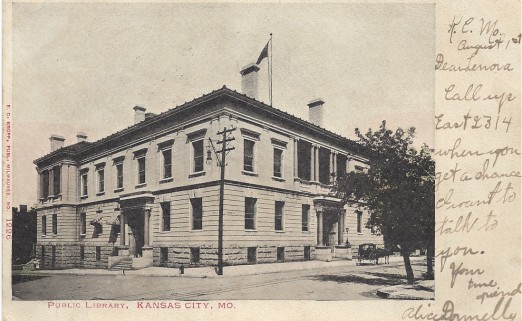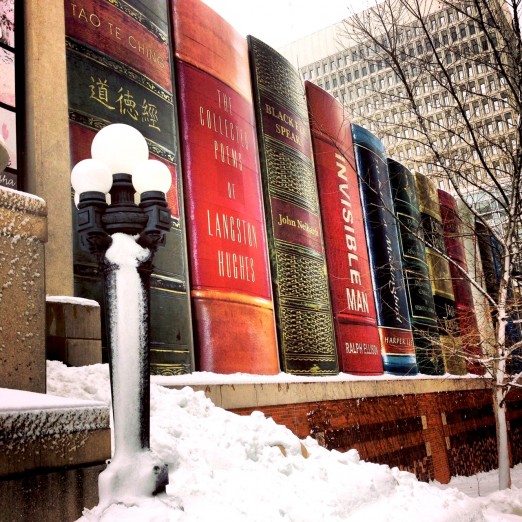Don’t Judge a Bank by its Cover
Any bookworm knows the feeling of intimidation and affection that comes from looking at his or her daunting shelf of unread books. Since 2004, the Community Bookshelf that spans 10th Street in downtown Kansas City, Mo., between Wyandotte Street and Baltimore Avenue, has inflated this once-private titillation to a grand, public scale. The larger-than-life shelf bears the 25-foot spines of classics like To Kill a Mockingbird and local interests like a Harry S. Truman biography. It has quickly become a beloved fixture of our cityscape, as well as a pesky reminder of all the books we’ve yet to read.
For some less familiar with the downtown quarter, the Community Bookshelf is sometimes referred to as “the downtown library.” The only thing to find in the stacks behind the big books, however, is parking—free for visitors to the adjacent library. Real books are in the equally striking building next door, at the Kansas City Public Library Central Branch: a marble marvel of neoclassical beauty that exudes culture, scholarship, knowledge.
Of course, this was only partially the original intention of the architectural firm Wight & Wight[1], Kansas City designers who built this stately structure in 1906 for the First National Bank and not for a library. The building, with its austere columns and grand interior, became more of a relic throughout the 20th century. The First National Bank continued to use it as something of an anchor location as they metastasized to newer, taller, more modern buildings in the growing downtown.

The original public library began with a simple set of encyclopedias in 1873. By 1889, it had moved to a small storefront at 8th and Oak Streets. By 1897, it had to move to bigger location on 9th and Locust Streets. This location housed murals, and grand meeting rooms and framed art. William Rockhill Nelson donated an art series to the library, which it renamed the Nelson Gallery of Art, leading to eventual expansion into the Nelson-Atkins Museum of Art. Eventually, the library moved into a more modern home in the 1960s—the Board of Education building, at 12th and McGee. The library had been an apparatus of the Kansas City Missouri School District since its inception, and together the two institutions weathered the changes of downtown and the city at large through the 1980s. The split came in 1988, but the nucleus Central Branch would not move to its new home on 10th Street until 2004.
Taking over the vacated First National Bank building at the dawn of the 21st Century, the Kansas City Public Library had entered a thrilling new era in a strikingly old building. Director Daniel Bradbury and his Board of Trustees emphasized the melding of historic preservation and burgeoning technology. Their vision included the “Library District,” a row of buildings on and off 10th Street that would reshape and reimagine a forgotten part of downtown.
Sounds overly ambitious? With a vision as big as a giant-sized bookshelf, one could have written the Kansas City Public Library off as the whimsy of a foolhardy daydreamer. But in less than a decade, the Central Branch has played an integral role in Kansas City Public Library’s boost in community programming, and become a downtown landmark.
The branch has found exciting ways to reap the benefits of their newfound banking heritage. The audio/visual department is located in the basement, adjacent to the charming old vault. Retaining its original steel structure and giant circle door, the safe now serves as a “film vault,” complete with a viewing room for curated screening events. Upstairs, a terrace has been converted into a playful observation deck, sporting a human-scale chess board open to any players.
It took the library taking a step in the past to help breathe new life to the downtown community. And the neighbors are grateful for it: “Our department has lots of historic photos,” Senior Special Collections Librarian Jeremy Drouin explains, “so people who move downtown into lofts have ordered pictures of their buildings, to celebrate their history.” The library has always aimed to help people learn about their history, but with the Central Branch it truly encourages its celebration.











